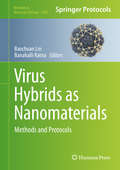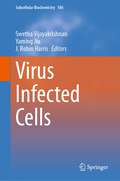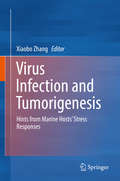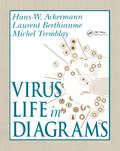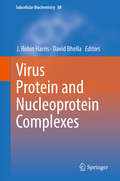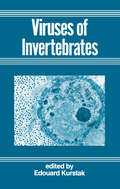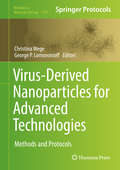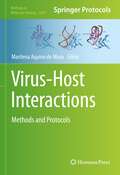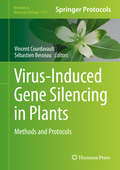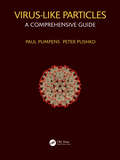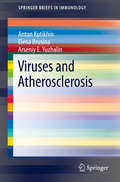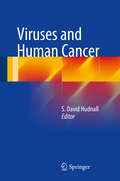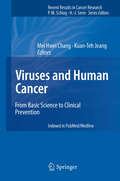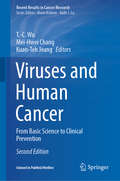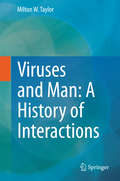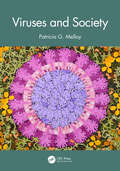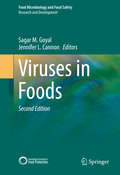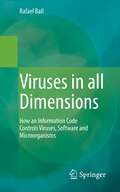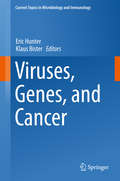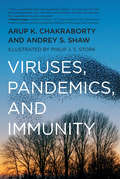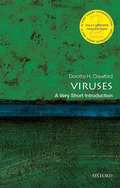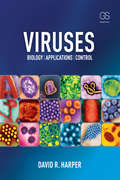- Table View
- List View
Virus Hybrids as Nanomaterials
by Baochuan Lin Banahalli RatnaIn Virus Hybrids as Nanomaterials: Methods and Protocols expert researchers in the field detail many of the methods used to study virus for medial and nonmedical applications. These include methods and techniques for genetically engineering viruses for therapeutic purpose and vaccine production, chemically modified viruses for virus-templated nanoparticles production, and genetically engineered or chemically modified viral particles as imaging agents. Written in the highly successful Methods in Molecular Biology series format, chapters include introductions to their respective topics, lists of the necessary materials and reagents, step-by-step, readily reproducible laboratory protocols, and key tips on troubleshooting and avoiding known pitfalls. Authoritative and practical, Virus Hybrids as Nanomaterials: Methods and Protocols seek to aid new researchers to get involved in this multidisciplinary area.
Virus Infected Cells (Subcellular Biochemistry #106)
by J. Robin Harris Swetha Vijayakrishnan Yaming JiuVirus-infected Cells is a comprehensive and technical exploration of the intricate interactions between viruses and host cells. This book delves into the molecular and cellular aspects of viral infections, providing a wealth of knowledge about various viruses and their effects on cellular mechanisms. The first part of the book covers general/technical aspects, introducing the reader to the field of virology and providing an overview of the techniques used to study virus-infected cells. It covers topics such as the visualisation of virus-infected cells by cryo-electron tomography and the assessment of necroptosis, a type of programmed cell death, in virus-infected cells. In addition, the book explores the role of apoptosis and phagocytosis as antiviral mechanisms, as well as the intricate process of viral membrane fusion and penetration. It also discusses the tracking of viral entry into living cells and the use of correlative cryo-imaging to study the biology of viruses in cells and tissues. Finally, the book examines the cytopathic effect induced by viruses, shedding light on the damage caused to infected cells. The second section of the book explores specific viruses and their interactions with host cells. Each chapter focuses on a specific virus and provides an in-depth look at its behaviour within infected cells. The book covers a wide range of viruses, including human papillomavirus, respiratory syncytial virus, Japanese encephalitis virus, African swine fever virus, coronavirus, influenza A virus and human endogenous retroviruses. Each chapter examines unique aspects of virus-host interactions, such as viral assembly, impact on the cytoskeleton, critical host-virus interactions mediated by viral RNA, mechanisms of cell entry, and the involvement of cholesterol in virus budding and scission. This volume in the Subcellular Biochemistry series is a valuable resource for researchers, virologists and students interested in understanding the complex dynamics between viruses and the cells they infect. With its detailed exploration of general and specific aspects of virus-host interactions, this book provides a comprehensive understanding of the molecular and cellular mechanisms involved in viral infections.
Virus Infection and Tumorigenesis: Hints from Marine Hosts’ Stress Responses
by Xiaobo ZhangThis book reviews the latest research on the molecules and mechanisms of marine host stress responses to viral infections and tumorigenesis. It offers an overview of the state of the art in the field as well as future directions. Metabolism disorder is a characteristic of tumorigenesis. Since viruses complete their life cycle in host cells, such infections cause metabolic disorders in the host. As such, the mechanisms of virus pathogenesis and tumor progression are similar or even identical. In essence, the role of antiviral molecules is to maintain the metabolic homeostasis of infected host cells, and the antiviral molecules induced by virus infection may play an important role in antitumor pathways, resulting in cancer cell death or restoring the disordered metabolism of cancer cells. The molecules generated during host stress responses to viruses can also contribute to the antitumor mechanisms in humans. However, the relationship between host stress responses to virus infection and tumorigenesis has not been extensively explored. In recent years, studies have shown that marine host stress responses to viral invasion can be good models for exploring human antitumor mechanisms. Stimulating further research in the field, this book offers graduate students and researchers with comprehensive insights into host stress responses to viral invasion and tumor progression. It is also a valuable resource for those working in the pharmaceutical industry interested in drug discovery based on molecules derived from host stress responses to viral infection.
Virus Life in Diagrams
by Michel Tremblay Hans-Wolfgang Ackermann Laurent BerthiaumeThis atlas presents 233 virus diagrams selected for their scientific content, clarity, originality, and historic, didactic, and aesthetic value. Virus Life in Diagrams assembles the many diagrams of viral life cycles, particle assembly, and strategies of nucleic acid replication that are scattered throughout the literature. The diagrams cover vertebrate, invertebrate, plant, bacterial, fungal, and protozoal viruses, viroids, and prions. They offer a dynamic illustration of the time course of viral life cycles not available in photographs. They also offer speculative elements that project the possible results of future research, as well as historical documentation that shows the development of virology. This valuable reference book for virologists, microbiologists, molecular biologists, geneticists, and students in these areas is the first atlas to compile illustrations of viral morphogenesis in one complete source.
Virus Protein and Nucleoprotein Complexes (Subcellular Biochemistry #88)
by J. Robin Harris David BhellaThe Subcellular Biochemistry series has recently embarked upon an almost encyclopaedic coverage of topics relating to the structure and function of macromolecular complexes (Volumes 82, 83 and 87). The present multi-author text covers numerous aspects of current research into molecular virology, with emphasis upon viral protein and nucleoprotein structure and function. Structural data from cryo-electron microscopy and X-ray crystallography is displayed throughout the book. The 17 chapters in the book cover diverse interesting topics, all currently under investigation, contributed by authors who are active actively involved in present-day research. Whilst structural aspects predominate, there is much consideration of the structure-function relationship. In addition, the book correlates with and extends from Volume 68 of the series “Structure and Physics of Viruses: An Integrated Textbook”. This book is directed primarily at professionals that work in the broad field of Structural Biology and will be of particular interest to Structural Virologists. The editors, David Bhella and Robin Harris, have much experience in virology and protein structure, respectively. Dr Bhella is Director of the Scottish Macromolecular Imaging Centre. Professor Robin Harris is the long-standing Series Editor of the Subcellular Biochemistry series. He has edited and contributed to several books in the series.
Virus of Invertebrates
by Edouard KurstakThe 300 known viruses that affect invertebrates, mostly insects, are important for research and for pest control. Twelve studies review the advances in the knowledge and use of these viruses made possible by biotechnological processes. Special attention is given to the baculoviridae family, but othe
Virus-Derived Nanoparticles for Advanced Technologies: Methods and Protocols (Methods in Molecular Biology #1776)
by Christina Wege George P. LomonossoffThis volume details protocols on virus-derived nanoparticles (VNPs) for a number of different applications. Chapters guide readers through the production of VNPs derived from plant, animal and bacterial viruses, prokaryotic and eukaryotic expression systems, encapsulation of heterologous materials within VNPs, and the modification of the outer surface of VNPs and how such modified VNPs can be developed into functional entities. Written in the highly successful Methods in Molecular Biology series format, chapters include introductions to their respective topics, lists of the necessary materials and reagents, step-by-step, readily reproducible laboratory protocols, and tips on troubleshooting and avoiding known pitfalls. Authoritative and practical, Virus-Derived Nanoparticles for Advanced Technologies: Methods and Protocols aims to ensure successful results in the further study of this vital field.
Virus-Host Interactions: Methods and Protocols (Methods in Molecular Biology #2610)
by Marilena Aquino de MuroThis detailed volume spotlights methods to investigate a variety of virus-host interactions in humans, other mammals, fish, or insects. It explores viruses such as white spot syndrome virus (WSSV), honeybee viruses, Nipah virus, EBV, SVCV, HSV-1, HIV-1, A H1N1, and SARS-CoV-2, as well as applications of techniques such as qPCR, serum antibody responses, 4C analysis, cell membrane fusion, biosensors, computational modelling, quantitative proteomics, and other genetic tools to decipher those viral infections and interactions. Written for the highly successful Methods in Molecular Biology series, chapters include introductions to their respective topics, lists of the necessary materials and reagents, step-by-step and readily reproducible laboratory protocols, and tips on troubleshooting and avoiding known pitfalls. Authoritative and practical, Virus-Host Interactions: Methods and Protocols serves as a valuable resource for researchers both in academia and in the biosciences industry who are engaged in the search for a better understanding of threatening virus-hosts interactions, virus detection, their characterization, and ultimately their taming and control.
Virus-Induced Gene Silencing in Plants: Methods and Protocols (Methods in Molecular Biology #2172)
by Vincent Courdavault Sébastien BesseauThis volume aims at providing a complete and updated overview of gene downregulation in plants performed through virus-induced gene silencing (VIGS). Chapters guide readers through classical and newly developed protocols of VIGS to allow readers to initiate or optimize their own silencing experiments according to the methods. Written in the highly successful Methods in Molecular Biology series format, chapters include introductions to their respective topics, lists of the necessary materials and reagents, step-by-step, readily reproducible laboratory protocols, and tips on troubleshooting and avoiding known pitfalls. Authoritative and cutting-edge, Virus-Induced Gene Silencing in Plants: Methods and Protocols aims to ensure successful results in the further study of this vital field.
Virus-Like Particles: A Comprehensive Guide
by Paul Pumpens Peter PushkoThis book represents the first complete and systematic guide to the virus-like particles (VLPs) and their applications as vaccines, therapeutic tools, nanomaterials, and nanodevices. The grouping of the VLPs follows the most recent virus taxonomy and the traditional Baltimore classification of viruses, which are based on the genome structure and mechanism of mRNA synthesis. Within each of the seven Baltimore classes, the order taxon serves as a framework of the chapter’s arrangement. The term "VLP" is used as a universal designation for the virus-, core-, or capsid-like structures, which became an important part of the modern molecular virology. The 3D structures, expression systems, and nanotechnological applications are described for VLPs in the context of the original viruses and uncover their evolving potential as novel vaccines and medical interventions. Key Features Presents the first full guide to the VLP nanotechnology, classified by current viral taxonomy Outlines specific structural properties and interconnection of the virions and VLPs Explains generation and characteristics of VLPs produced by various expression systems Offers up-to-date summary of VLPs designed as vaccines and delivery tools Unveils interconnection of VLPs with novel organic and inorganic nanomaterials
Viruses and Atherosclerosis
by Arseniy E. Yuzhalin Anton Kutikhin Elena BrusinaWill address an important, yet underrepresented, topic. The correlation between viruses and atherosclerosis has been a focal point of the authors' work, for a number of years. This volume will explore the relationship between different viral strains and atherosclerosis. It will begin by describing the hypothesis and denoting the mechanisms of virus-driven atherosclerosis, then expanding on the subject by focusing on different virus strains--from Herpes, to Epstein-Barr, to the triad of Hepatitis viruses, et al--on a chapter-by-chapter basis. While there are books, albeit few, that cover particular viral strains and their relationship to cardiovascular diseases, this work will be unique in its scope by considering multiple strains of viruses, making it a repository of information on the topic; a truly comprehensive volume.
Viruses and Human Cancer
by S. David HudnallViruses and Human Cancer provides a comprehensive review of the seven currently known human tumor viruses and their associated cancers with an emphasis on epidemiology, clinicopathologic features, and pathogenesis. Chapters are written by internationally recognized experts and all are generously illustrated with tables, diagrams and photographic images. Viruses and Human Cancer is designed to serve as a concise review of the field of human tumor virology for pathologists, oncologists and infectious disease specialists. It will also be of great value to practicing physicians, residents and clinical fellows in these specialties.
Viruses and Human Cancer: From Basic Science to Clinical Prevention
by Mei Hwei Chang Kuan-Teh JeangResearch on oncogenic viruses and related human cancers has advanced rapidly in the past decade. Most articles, however, focus on a specific oncogenic virus and cancer. There is consequently a need for a comprehensive, up-to-date monograph that offers broad and integrated knowledge. Viruses and Human Cancer - From Basic Science to Clinical Prevention is designed to meet this need by providing an advanced overview on the basic and clinical aspects of oncogenic viruses and the human cancers that they cause. Virology, virus-induced inflammation and tissue injuries, oncogenic mechanisms, epidemiology, and current and emerging preventive and therapeutic strategies are all discussed in detail. In addition, the book covers the individual aspects of seven oncogenic viruses, i.e., hepatitis B virus, hepatitis C virus, human papilloma virus, Epstein-Barr virus, human T-cell lymphotropic virus, Kaposi sarcoma-associated herpes virus, and Merkel cell polyomavirus, and the related human cancers.
Viruses and Human Cancer: From Basic Science to Clinical Prevention (Recent Results in Cancer Research #217)
by Kuan-Teh Jeang Mei-Hwei Chang T. C. WuThis book, in a new, extensively updated edition, covers viral infection, virus-induced inflammation and tissue injuries, viral epidemiology, oncogenic mechanisms, and current and emerging preventive and therapeutic strategies in detail. Readers will also find information on the individual aspects of a number of oncogenic viruses, including hepatitis B, hepatitis C, human papillomavirus, Epstein–Barr virus, human T-cell lymphotropic virus, Kaposi sarcoma-associated herpes, and Merkel cell polyomavirus, as well as associated human cancers. The book will benefit all those who are seeking a comprehensive, up-to-date overview of the basic and clinical aspects of oncogenic viruses and associated human cancers. Following its original publication in 2014, the first edition of this book quickly became an influential text in the field. This second edition duly reflects the significant advances in knowledge and research that have been achieved in the years since.
Viruses and Man: A History of Interactions
by Milton W. TaylorMilton Taylor, Indiana University, offers an easy-to-read and fascinating text describing the impact of viruses on human society. The book starts with an analysis of the profound effect that viral epidemics had on world history resulting in demographic upheavals by destroying total populations. It also provides a brief history of virology and immunology. Furthermore, the use of viruses for the treatment of cancer (viral oncolysis or virotherapy) and bacterial diseases (phage therapy) and as vectors in gene therapy is discussed in detail. Several chapters focus on viral diseases such as smallpox, influenza, polio, hepatitis and their control, as well as on HIV and AIDS and on some emerging viruses with an interesting story attached to their discovery or vaccine development. The book closes with a chapter on biological weapons. It will serve as an invaluable source of information for beginners in the field of virology as well as for experienced virologists, other academics, students, and readers without prior knowledge of virology or molecular biology.
Viruses and Society
by Patricia G. MelloyViruses and Society is geared towards professionals and students in college-level introductory biology courses devoted to understanding viruses, vaccines, and their global impact. The beginning of the book introduces cells, DNA, and viruses themselves. There follows a review of how the immune system works and how scientists and physicians harness the immune system to protect people through vaccines. Specific chapters will focus on the 1918 influenza pandemic, the fight to eradicate polio, the HIV/AIDS pandemic, and our current COVID-19 crisis. Additionally, the book reviews the uses of viruses in genetic engineering and in gene therapy as well. The book will conclude by describing public health initiatives to keep emerging viruses in check and the role of scientific communication in how viruses are perceived and have an impact on our society. Key Features 1) The text employs approachable and simplified language 2) Provides all the essential elements for understanding virus biology 3) Includes details on how viruses affect individuals 4) Describes the ways public health decisions are made in light of how viral pathogens spread 5) Highlights up to date scientific findings on the features of emerging viruses that will always be with us
Viruses in Foods
by Sagar M. Goyal Jennifer L. CannonFoodborne viruses are an important group of pathogens recognizedto cause significant disease globally, in terms of both number ofillnesses and severity of disease. Contamination of foods by enteric viruses, such ashuman norovirus and hepatitis A and E viruses, is a major concern to publichealth and food safety. Food Virology is a burgeoning field of emphasis for scientificresearch. Many developments in foodborne virus detection, prevention and control havebeen made in recent years and are the basis of this publication. This second edition of Viruses in Foods provides anup-to-date description of foodborne viruses of public health importance, including theirepidemiology and methods for detection, prevention and control. It uniquely includes casereports of past outbreaks with implications for better control of future outbreaks, asection that can be considered a handbook for foodborne virus detection, and updated andexpanded information on virus prevention and control, with chapters on naturalvirucidal compounds in foods and risk assessment of foodborne viruses.
Viruses in all Dimensions: How an Information Code Controls Viruses, Software and Microorganisms
by Rafael BallMicroorganisms, viruses, and computer programs encode all the information necessary to reproduce and spread themselves. Yet these mechanisms are amazingly similar in the animate world, in the world of viruses, and even in the world of technical systems. The book shows how great the parallels are between these various animate and inanimate replicating systems and what they are based on.The excursion also leads into the fascinating world of genetics, to the question of what defines life and into the programming of software that multiplies itself independently. Finally, the question is derived whether and to what extent such self-replicating technical systems can become as dangerous as infectious viruses in triggering pandemics, such as the Corona pandemic in 2020.
Viruses, Genes, and Cancer (Current Topics in Microbiology and Immunology #407)
by Eric Hunter Klaus BisterThis volume focuses on virus-host cell interactions, cellular genes acquired or modulated by viruses, the pathological effects of these interactions, and therapeutic interventions. Several chapters specifically address the role of viruses and genes - such as oncogenes, proto-oncogenes, or tumor suppressor genes - in the etiology of human cancer. Oncogenic signaling by PI3 kinase, mTOR, Akt, or the major cancer drivers MYC and RAF, and the role of tumor suppressors like p53, are discussed in detail. The volume also explores the emerging role of noncoding RNAs such as microRNAs in tumorigenesis and cancer therapeutics, and offers new insights into the role of HIV-host interactions relevant to pathogenesis and treatment. Gathering contributions written by leading scientists in their respective fields, the volume offers a valuable resource for researchers and clinicians alike.
Viruses, Pandemics, and Immunity
by Arup K. Chakraborty Andrey ShawHow viruses emerge to cause pandemics, how our immune system combats them, and how diagnostic tests, vaccines, and antiviral therapies work.Throughout history, humans have contended with pandemics. History is replete with references to plagues, pestilence, and contagion, but the devastation wrought by pandemics had been largely forgotten by the twenty-first century. Now, the enormous human and economic toll of the rapidly spreading COVID-19 disease offers a vivid reminder that infectious disease pandemics are one of the greatest existential threats to humanity. This book provides an accessible explanation of how viruses emerge to cause pandemics, how our immune system combats them, and how diagnostic tests, vaccines, and antiviral therapies work-- concepts that are a foundation for our public health policies.
Viruses: A Very Short Introduction (Very Short Introductions)
by Dorothy H. CrawfordViruses are big news. From pandemics such as HIV, swine flu, and SARS, we are constantly being bombarded with information about new lethal infections. In this Very Short Introduction Dorothy Crawford demonstrates how clever these entities really are. From their discovery and the unravelling of their intricate structures, Crawford demonstrates how these tiny parasites are by far the most abundant life forms on the planet. With up to two billion of them in each litre of sea water, viruses play a vital role in controlling the marine environment and are essential to the ocean's delicate ecosystem. Analyzing the threat of emerging virus infections, Crawford recounts stories of renowned killer viruses such as Ebola and rabies as well as the less known bat-borne Nipah and Hendra viruses. Pinpointing wild animals as the source of the most recent pandemics, she discusses the reasons behind the present increase in potentially fatal infections, as well as evidence suggesting that long term viruses can eventually lead to cancer. By examining our lifestyle in the 21st century, Crawford looks to the future to ask whether we can ever live in harmony with viruses, and considers the ways in which we may need to adapt to prevent emerging viruses with devastating consequences.
Viruses: Agents of Evolutionary Invention
by Michael G. CordingleyWhile viruses—the world’s most abundant biological entities—are not technically alive, they invade, replicate, and evolve within living cells. Michael Cordingley goes beyond our familiarity with infections to show how viruses spur evolutionary change in their hosts and shape global ecosystems, from ocean photosynthesis to drug-resistant bacteria.
Viruses: Biology, Applications, and Control
by David HarperViruses: Biology, Application, and Control is a concise advanced undergraduate and graduate textbook covering the essential aspects of virology included in biomedical science courses. It is an updated and expanded version of David Harper‘s Molecular Virology 2e from the Medical Perspectives series. Selected Contents: 1. Virus Structure and Infection 2. Virus classification and evolution 3. Virus Replication 4. Viral Interaction with the Immune System 5. Vaccines and vaccination 6. Antiviral Drugs 7. Beneficial Use of Viruses 8. Emergence, transmission, and extinction 9. Viruses, vectors, and genomics 10. Virus Culture, Detection and Diagnosis Viral Replication Strategies Appe
Viruses: Essential Agents of Life
by Günther WitzanyA renaissance of virus research is taking centre stage in biology. Empirical data from the last decade indicate the important roles of viruses, both in the evolution of all life and as symbionts of host organisms. There is increasing evidence that all cellular life is colonized by exogenous and/or endogenous viruses in a non-lytic but persistent lifestyle. Viruses and viral parts form the most numerous genetic matter on this planet.
Vis Vim Vi: Declinations of Force in Leibniz’s Dynamics
by Tzuchien ThoThis book presents a systematic reconstruction of Leibniz's dynamics project (c. 1676-1700) that contributes to a more comprehensive understanding of the concepts of physical causality in Leibniz's work and 17th century physics. It argues that Leibniz's theory of forces privileges the causal relationship between structural organization and physical phenomena instead of body-to-body mechanical causation. The mature conception of Leibnizian force is not the power of one body to cause motion in another, but a kind of structural causation related to the configuration of integral systems of bodies in physical evolution. By treating the immanent philosophy of Leibniz's dynamics, this book makes explicit the systematic aims and inherent limits of Leibniz's physical project, in addition to providing an alternative vision of the scientific understanding of the physical world in the late 17th and early 18th century.
